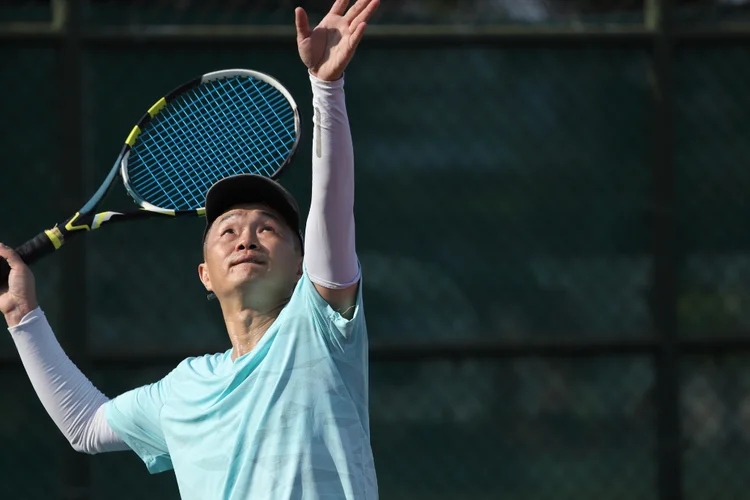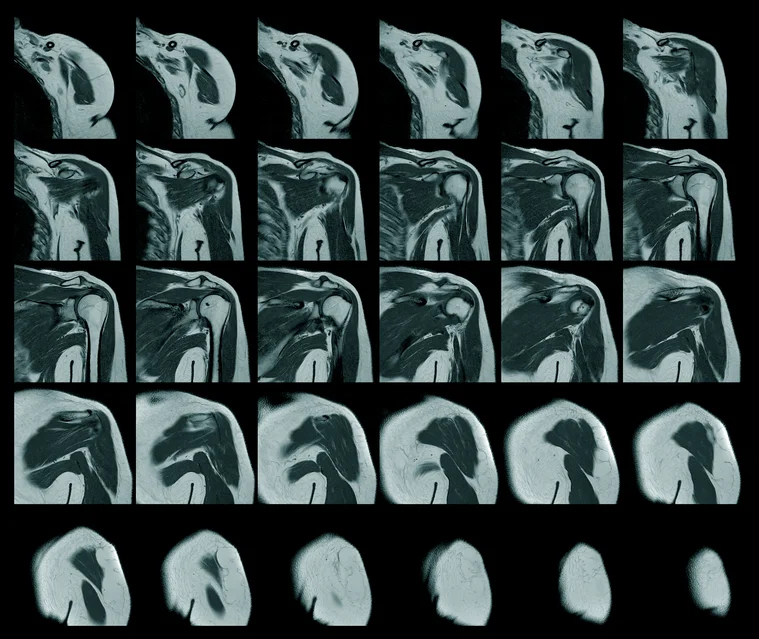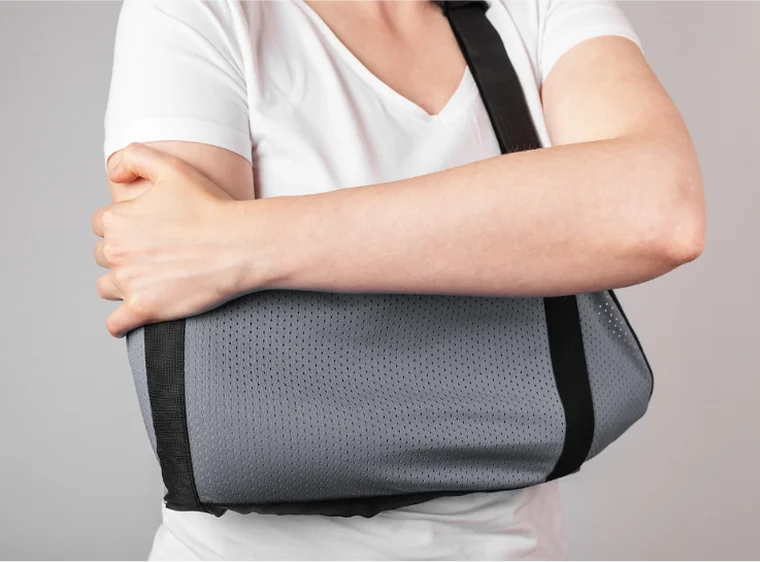Shoulder Labral (SLAP) Tear: Symptoms & Treatment
Information reviewed by: Dr. Foo Gen Lin | Last updated: Oct 29, 2025
Labral or SLAP tears affect shoulder cartilage due to trauma or repetitive motion. Dr Foo provides precise diagnosis and minimally invasive care to relieve pain, restore stability, and support safe return to activity.
MBBS (University of London) | MMed (Ortho) | FRCSEd (Ortho) | FAMS (Ortho)


What Is a Shoulder Labral (SLAP) Tear?
A shoulder labral tear, specifically a Superior Labrum Anterior and Posterior (SLAP) tear, is an injury to the cartilage lining the shoulder socket (glenoid labrum). It occurs at the upper (superior) part of the labrum, where the biceps tendon attaches, often causing pain, instability, and reduced shoulder function.

The labrum is essential for shoulder stability, cushioning the upper arm bone (humerus) and
supporting key tendons and ligaments.
As such, a SLAP tear can significantly impact
daily activities and quality of life,
making tasks such as lifting objects, reaching overhead, carrying groceries, or even
sleeping on the affected shoulder uncomfortable. Athletes and individuals with physically
demanding jobs may experience reduced strength and
mobility, impacting their performance and ability to work.
Types of Labral Tears
While SLAP tears are one of the most common labral injuries in the shoulder, other types of labral tears can also occur, depending on the location and cause of the damage:
1. Bankart Tear
- A Bankart tear, also known as a Bankart lesion, occurs in the lower front (anterior-inferior) portion of the labrum, typically following a shoulder dislocation.
- Common in younger individuals and contact sport athletes.
- Can cause recurrent shoulder instability and a feeling of the shoulder "slipping out".
2. Posterior Labral Tear
- Affects the back (posterior) part of the labrum.
- Often results from forceful pushing motions, such as in weightlifting or football blocking.
- May cause deep shoulder pain, weakness, and difficulty pushing objects away from the body.
What Causes a SLAP Tear?
A SLAP tear occurs when excessive force or repetitive strain pulls, compresses, or twists the superior labrum, causing it to tear or detach from the shoulder socket. Common causes include:

- Degenerative Wear – Age-related changes can lead to gradual labral weakening, making it more prone to fraying or tearing with minor stress.
- Repetitive Shoulder Movements – Jobs or activities that require frequent overhead arm use (e.g., painting, construction work) increase strain on the labrum over time.
- Sports Injuries – Repetitive overhead motions in sports like baseball, tennis, swimming, and weightlifting can place excessive stress on the labrum.
- Falls and Direct Impact – Landing on an outstretched hand, falling onto the shoulder, or sustaining a direct blow can create a shearing force that tears the labrum.
Shoulder Labral (SLAP) Tear Symptoms
SLAP tear symptoms vary based on the severity and location of the tear. Common signs include:
- Shoulder Pain – A deep, aching pain, particularly with overhead movements or prolonged activity, is the most frequently reported symptom.
- Weakness and Instability – Reduced shoulder strength and stability, especially during overhead or rotational movements, can make daily tasks and sports activities challenging.
- Clicking, Popping, or Catching – A sensation of grinding, locking, or instability when moving the arm may indicate mechanical irritation in the joint.
- Limited Range of Motion – Difficulty lifting, rotating, or fully extending the arm due to stiffness, discomfort, or mechanical restriction.
How Is a SLAP Tear Diagnosed?
Diagnosing a SLAP tear involves a medical history review, clinical evaluation, and imaging tests to assess the severity of the injury and guide treatment.

- Medical History Review – A review of your symptoms, previous shoulder injuries, repetitive activities, and any history of trauma to assess potential causes and contributing factors.
- Physical Examination – A hands-on evaluation of shoulder mobility, strength, and pain patterns, using targeted tests such as the O’Brien test, Speed’s test, and Yergason’s test, helps determine labral involvement.
- Magnetic Resonance Imaging (MRI) – An MRI provides detailed visuals of labral damage, helping identify tears that may not appear on a standard MRI.
- X-rays – While X-rays cannot detect soft tissue damage, they help rule out fractures, bone spurs, or other structural abnormalities that could contribute to symptoms.
- Arthroscopy – In some cases, a minimally invasive surgical procedure allows direct visualisation of the labrum inside the joint, making it the most definitive method for diagnosing a SLAP tear.
Labral Tear Shoulder Treatment
SLAP tear treatment depends on the severity of the injury, pain level, and how shoulder function affects daily activities. Non-surgical approaches are typically the first line of treatment, with surgery considered if symptoms persist.
| Treatment Approach | Description & Purpose |
|---|---|
| Non-Surgical Management | |
| Rest and Activity Modification | Avoiding repetitive overhead movements and high-impact activities allows the labrum to heal naturally by reducing strain on the shoulder joint. This is often the first step in managing mild to moderate SLAP tears. |
| Physical Therapy | A structured rehabilitation programme that focuses on strengthening the rotator cuff and scapular stabilisers, improving shoulder stability, flexibility, and function. |
| Pain Management | Pain medications such as non-steroidal anti-inflammatory drugs (NSAIDs) help reduce inflammation and alleviate pain associated with SLAP tears. These are typically used in conjunction with other treatments like physical therapy. |
| Injection-Based Treatments | Corticosteroid injections help reduce inflammation in the shoulder joint, providing targeted pain relief and short-term symptom management. Platelet-Rich Plasma (PRP) injections may be used to promote tissue healing by drawing a small amount of the patient’s blood, concentrating platelets and growth factors, and injecting them into the injured area. |
| Surgical Intervention | |
| Arthroscopic Labral Repair | A minimally invasive surgery where small incisions are made to reattach the torn labrum to the glenoid using sutures or anchors. This restores shoulder stability and prevents further damage. |
| Arthroscopic Labral Debridement | For minor SLAP tears that do not significantly impact shoulder stability, arthroscopic trimming and removal of frayed or damaged tissue can reduce pain and irritation, improving function without extensive reconstruction. |
| Biceps Tenodesis | A surgical procedure performed when a SLAP tear involves the biceps tendon. The tendon is detached from the labrum and reattached lower on the humerus, reducing strain on the torn labrum and preventing ongoing irritation. |
Shoulder Labral (SLAP) Tear Recovery

Recovery time for a SLAP tear depends on the treatment approach, severity of the tear, and individual healing factors:
- Non-Surgical Rehabilitation – Typically 6 to 12 weeks, focusing on pain management, mobility restoration, and progressive strengthening exercises.
- Post-Surgical Recovery – Arthroscopic labral repair and biceps tenodesis require 4 to 6 weeks of sling immobilisation, followed by 3 to 6 months of physiotherapy to restore strength, mobility, and shoulder stability. Recovery after debridement is typically quicker, often requiring minimal sling use and a shorter rehabilitation period.
Return to sports or heavy activity usually depends on the extent of healing, adherence to rehabilitation, and sport-specific demands. Your specialist will provide personalised guidance based on your condition and recovery progress.
Can a SLAP Tear Be Prevented?
While not all SLAP tears can be prevented, minimising strain on the shoulder joint can lower the risk:
- Strengthen Shoulder Muscles – Strengthening the rotator cuff and scapular stabilisers (serratus anterior, trapezius, rhomboids, and levator scapulae) help to improve shoulder stability, labral support, and injury prevention.
- Improve Shoulder Flexibility – Proper warm-ups, stretching, and mobility exercises help reduce excessive strain on the shoulder.
- Use Proper Techniques – Maintaining correct overhead mechanics and posture to minimise unnecessary stress on the shoulder joint.
- Avoid Overuse – Adequate rest and recovery between repetitive movements help prevent cumulative wear and tear on the labrum.
Every patient deserves a treatment plan tailored to their needs. We start with non-surgical approaches before considering more invasive interventions.
Find an Orthopaedic Specialist Near Me
Apex Novena
admin@apexsportsclinic.sg
101 Irrawaddy Rd, #18-12 Royal Square Medical Centre, Singapore 329565
Nearest MRT: NS20 Novena
Apex East Coast
admin@apexsportsclinic.sg
112 E Coast Rd, #03-03/04 i12 Katong, Singapore 428802
Nearest MRT: TE26 Marine Parade
Why Do Patients Choose Apex Sports Clinic?
Sports Doctor in Singapore: Personalised & Affordable Care
Progressive Treatment Philosophy
We prioritise personalised, non-invasive solutions, progressing to specialised treatments, including surgery, only when needed for more effective and targeted care.
Holistic Patient-Centred Care
From diagnosis to rehabilitation, we provide comprehensive and seamless care for a wide range of orthopaedic conditions.
Specialist in Sports Orthopaedics & Injury Management
We combine expert injury management with a proactive approach to maintaining your body's strength and function, so you can recover fully and perform at your peak.
Patient Journey
1 . Schedule Your Appointment

2 . Expert Diagnosis & Consultation

3 . Customised Treatment Plan

Schedule an Appointment

Our Insurance Partners






Frequently Asked Questions (FAQs)
A SLAP tear may not fully heal on its own because the labrum has limited blood supply, particularly in the upper region where tears often occur. However, mild or partial tears can improve with rest, physiotherapy, and activity modification to strengthen surrounding muscles and stabilise the joint. If you suspect a labral tear or experience persistent symptoms, it is best to seek a proper diagnosis and appropriate treatment.
A labral tear in the shoulder can be a serious injury depending on its size and location, as it may affect shoulder stability and function. Minor tears may only cause mild discomfort, while larger or unstable tears can result in persistent pain, weakness, or recurrent dislocations if untreated. If you suspect a labral tear or have ongoing shoulder symptoms, it is advisable to seek a proper diagnosis and timely treatment from a specialist.
A SLAP tear often causes a deep, aching pain inside the shoulder joint, especially during overhead or twisting movements. Individuals may also feel clicking, catching, or a sensation of the shoulder “giving way,” accompanied by weakness or reduced range of motion. Symptoms can worsen with lifting, throwing, or reaching behind the back. If you experience persistent pain or instability or suspect a shoulder labral (SLAP) tear, it is advisable to seek proper diagnosis and treatment.
The impact of a torn rotator cuff versus a torn labrum depends on the tear’s severity and the individual’s activity level. A rotator cuff tear affects shoulder strength and lifting ability, while a labral tear primarily affects stability and joint mechanics. Both can cause significant pain and functional limitations if untreated.
Treatment for a labral tear depends on its type, severity, and symptoms. Non-surgical options such as physiotherapy, rest, and anti-inflammatory medication can help in mild cases. More severe or persistent tears may require arthroscopic surgery to repair or trim the damaged labrum and restore shoulder stability. If you suspect a shoulder labral tear or experience ongoing symptoms, it is advisable to consult an orthopaedic specialist for personalised treatment guidance.
If left untreated, a SLAP tear may cause persistent shoulder pain, weakness, and instability that can worsen over time. The tear may enlarge or place extra stress on nearby muscles and tendons, increasing the risk of further injury. While mild tears may be manageable with activity modification, untreated tears can affect daily function. If symptoms persist, it is best to consult an orthopaedic specialist for proper evaluation and care.
Activities that strain or twist the shoulder, such as repetitive overhead movements, heavy lifting, or throwing, can worsen a SLAP tear. Sudden jerking motions or weight training without proper form may also aggravate symptoms. During recovery, it is best to avoid high-impact or overhead exercises until cleared by your specialist or physiotherapist, who can guide appropriate modifications to protect the healing labrum.
The best sleeping position for a torn shoulder labrum is typically on your back or the uninjured side with the affected arm supported by a pillow to reduce strain. Sleeping on the injured shoulder should be avoided, as it may worsen pain and inflammation. A reclined position may also help maintain comfort and stability. It is advisable to follow your specialist’s or physiotherapist’s recommendations for suitable sleeping positions during recovery.
A standard MRI can sometimes detect a labral tear, but smaller or partial tears are often difficult to visualise without contrast. An MRI arthrogram, which uses a contrast dye injected into the shoulder joint, provides clearer imaging and is typically more accurate for diagnosing SLAP tears.
A SLAP tear can be mistaken for conditions such as rotator cuff injuries, biceps tendinopathy, shoulder impingement, or arthritis, as they share similar symptoms like pain, weakness, and restricted movement. Accurate diagnosis usually requires a clinical examination and imaging tests. If you are experiencing shoulder pain or suspect a labral tear, it is best to consult a shoulder specialist for proper assessment and management.
Surgery is not always necessary for a SLAP tear, as many mild or stable tears improve with physiotherapy, rest, and activity modification. However, surgical repair may be recommended if pain or instability continues despite conservative care, particularly for athletes or individuals with high shoulder demands. The need for surgery depends on the tear type, symptom severity, and activity level. It is best to discuss your options with an orthopaedic specialist.
A rotator cuff tear usually causes pain and weakness when lifting or rotating the arm, whereas a labral tear often results in deep shoulder pain, clicking, or a feeling of instability. The impact of each injury varies depending on its severity and location. Imaging such as MRI is needed for accurate diagnosis. If you are experiencing symptoms or suspect either tear, it is advisable to consult a shoulder specialist for evaluation.
Surgery for a shoulder labral tear is considered when non-surgical treatments such as physiotherapy and injections do not relieve pain or restore function. It may also be recommended for individuals with recurrent instability or high physical demands. Surgical repair can restore stability and prevent further damage but requires structured rehabilitation. It is best to discuss the potential benefits and recovery expectations with your orthopaedic specialist.
A shoulder labral tear can occasionally cause referred pain or tension in the neck and upper back as surrounding muscles overwork to compensate for shoulder instability. This muscular strain may lead to stiffness or discomfort in nearby areas. However, neck or back pain can also arise from unrelated issues such as cervical spine problems. If you are experiencing persistent pain or stiffness, it is best to seek medical evaluation for an accurate diagnosis.
Recovery from a shoulder labral tear varies based on severity and treatment. Non-surgical recovery typically takes 6 to 12 weeks, while surgical repair may require 4 to 6 months with physiotherapy to restore strength and stability. Athletes or those with physically demanding jobs may need additional time before returning to full activity. It is advisable to discuss expected recovery and rehabilitation progress with your specialist.
A SLAP tear is not necessarily career ending, even for athletes or individuals in physically demanding roles. Many return to full function after appropriate rehabilitation or surgical repair. However, recovery outcomes depend on tear severity, treatment success, and adherence to physiotherapy. Some high-level athletes may experience performance limitations if shoulder stability or power does not fully recover. It is best to consult your orthopaedic specialist to discuss prognosis based on your goals.
It is usually possible to lift your arm with a SLAP tear, though the movement may feel painful, weak, or limited, particularly during overhead lifting or carrying objects. The extent of restriction depends on the severity of the tear and surrounding inflammation. Overexertion may aggravate symptoms or delay recovery. It is advisable to avoid strenuous activity and consult a specialist or physiotherapist for appropriate guidance.
Movements that involve overhead reaching, lifting, or throwing often cause pain with a SLAP tear. Rotational or pushing motions, such as serving in tennis or pressing weights, can also aggravate symptoms due to strain on the labrum and biceps tendon. Pain may intensify when the arm is extended behind the back or under load. Avoiding these movements until cleared by your specialist or physiotherapist helps prevent further shoulder irritation or injury.
A labral tear may cause deep shoulder pain, clicking, or a catching sensation when moving the arm, along with weakness, instability, or reduced range of motion. However, these symptoms can resemble other shoulder conditions such as rotator cuff or tendon injuries. If you suspect a labral tear or experience persistent symptoms, it is best to consult a shoulder specialist for a proper diagnosis and appropriate management.
A shoulder brace may provide temporary stability and reduce discomfort by limiting excessive motion, especially in mild or healing labral tears. However, it cannot repair the tear or replace proper rehabilitation. Bracing is typically used alongside physiotherapy to strengthen shoulder-supporting muscles and improve control. It is advisable to consult your specialist or physiotherapist to determine if a brace is suitable for your specific condition.
Massage can help relieve muscle tension and improve circulation around the shoulder, which may ease discomfort associated with a SLAP tear. However, deep or aggressive techniques directly over the joint should be avoided, as they can aggravate inflammation or instability. Gentle soft-tissue massage may complement physiotherapy. It is advisable to consult your shoulder specialist or physiotherapist before starting massage to ensure it aligns with your treatment plan.

